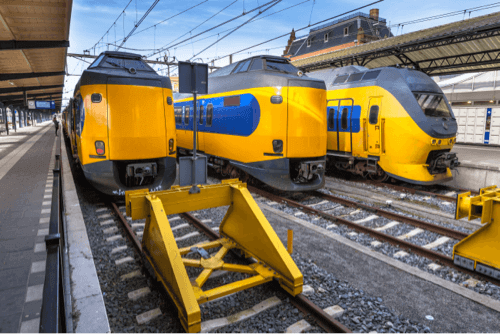
Mexican Railroads: Discover its history and expansion projects
In 2019, Mexico was the 10th most exported country in the world, generating revenue of approximately $338 billion. Even though, as in Brazil, the most used mode of transport is road, the Mexican railroads play a very important role in the country's internal and external trade.
The main type of product transported by Mexican railroads is automobile parts. This category, which includes cars, motorcycles, tractors and industry accessories, earned $72.6 billion in 2019.
Next are electronic devices, such as microphones, monitors, televisions, computer parts. In 2019, export revenue from this type of item surpassed the $70 billion mark.
Fossil fuels, such as oil and coal, also play a central role in the Mexican economy, earning around US$22 billion through exports.
Now that we know some of the main products that occupy freight trains in Mexico, let's learn a little about rail transport in the country.
Content Index
Emergence of the Mexican railroads

Entrepreneur Antonio Escandón was one of the first Mexicans who saw great economic potential in the construction of railroads in the country. In 1857, he proposed to finance a line that would connect Mexico City to Vera Cruz, a port city located on the coast of the Gulf of Mexico. However, due to a period of political instability, the works did not progress.
It was not until 1864, during Maximilian's empire, that construction was resumed. The inauguration took place in 1873, being called Ferrocarril Imperial Mexicano (Imperial Mexican Railroad).
The following decades, more specifically during the mandates of Presidents Manuel González and Porfirio Díaz, were marked by major government incentives aimed at expanding the rail network. Through subsidies and concessions to private companies, the railroads grew considerably: in 1910, Mexico already had about 24,720 km of tracks in its territory.
It is important to remember that most of the country's first railroad lines were foreign-owned. Therefore, in 1900, the Secretariat of Finance and Public Credit created the first General Law on Railroad, which limited concessions only to projects that could benefit the country's economy.
In addition, the state-owned railroad company Ferrocarriles Nacionales de México (National Railroads of Mexico) was created in 1903, during the government of Porfírio Díaz, with the aim of directing the use of the routes to serve public interests.
Active Mexican Railroads

In 1995, through an attempt to revitalize the Mexican railroads, the country's government opted to privatize the National Railroads of Mexico.
Kansas City Southern Mexico (KCSM) purchased the northeast part of the network, which connects various points of interest in the country, totaling 3,638 km in length. Among the main linked sites are Mexico City, Monterrey, the port city of Lázaro Cárdenas, and Novo Laredo, which borders the Texan state. This company is exclusively dedicated to the transport of cargo, more specifically, the export of parts for land vehicles.
Since 1998, Grupo México and Union Pacific Railroad will jointly compare themselves with the northwest of the Mexican National Railroad network. This is how Ferromex was founded, responsible for managing around 9,610 km of tracks.
Finally, the southern segment of the network was in charge of Ferrosur, totaling 2,654 km of lines, including the one that connects Mexico City to the Gulf of Mexico in Vera Cruz.
Interconnection with the USA

In 2019, about 77.8% of all product exports from Mexico went to the United States, totaling about $286.2 billion in revenue. This index is only possible through the connections between the Mexican and North American railroads, so let's get to know a little about the ports of entry.
The companies from Mexico that make these connections are Ferromex and Kansas City Southern de Mexico.
The gateways used by Ferromex trains are located in: Calexico, California; El Paso and Eagle Pass, Texas; and Nogales in Arizona.
In the case of Kansas City Southern de Mexico, the lines lead to the North American territory through the Texan cities, Laredo and Brownsville.
Investments and modernization

As was said at the beginning of this article, rail is not the most popular means of transport in mexico. For example, according to a study carried out by Bloomberg, freight transportation by trucks totaled 82.5%, while transportation by trains was 16.7% in 2015.
However, the disparity between these two modes has gradually diminished over the years. Depending on the type of cargo, road transport may not be the most profitable logistics solution, so new investments are being planned to improve Mexican railroads.
The current president of Mexico, Andrés Manuel López Obrador, plans to build around 2,000 km of new tracks in the country. One of the projects initiated during his tenure is the construction of a line between Toluca and Mexico City. In this case, investments total up to US$4.5 billion, with opening scheduled for 2023.
There are also other government projects that aim to modernize and expand passenger rail transport, they are: the bullet train from Mexico City to Querétaro, the Interurban Train from León to Celaya, the Suburban Railroad from Lechería to Felipe Ángeles International Airport and the Suburban Train from García to Monterrey Airport.
Another event that promises to boost the rail modal in Mexico is the purchase by the Canadian Pacific Railroad of KSC Southern, the company that operates the activities of Kansas City Southern de Mexico. The deal involved a $25 billion transaction and plans to create a railroad that will cross Canada, the US and Mexico.
According to Canadian Pacific Railroad Chief Executive Keith Creel, the project will bring benefits to employees, customers, the communities involved and shareholders.
Conclusion
The secret to a profitable trade is to plan logistics processes well and thus reduce costs. Therefore, cargo transport is a fundamental part of most economic activities of a company.
In the case of Mexico, the road modal is still the protagonist in the flow of products. Therefore, the solution may be to reduce dependence on the road system and balance demand with other modes, such as rail, for example.
Searchs:
http://wits.worldbank.org/visualization/country-analysis-visualization.html












